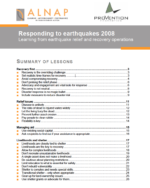
Responding to earthquakes 2008, Learning from earthquake relief and recovery operations
John Cosgrave
Report, English, 40 pages
Summary
This paper aims to provide a distillation of the learning from thirty years of humanitarian response to earthquakes. It concentrates on issues of particular relevance in earthquakes. The paper assumes that readers are already familiar with the more general lessons in the aid sector such as the key roles of needs assessment, effective coordination, accountability and consultation with the affected population. The main intended audiences are operational decision-makers and relief programme managers working in the response to such sudden-onset natural disasters. Sadly, many of these lessons are not new. This is a thorough rewriting of two previous briefing papers prepared for the humanitarian and development communities by ALNAP (www.alnap.org) and the ProVention Consortium (www.proventionconsortium.org).1 The first paper dealt with relief, and the second with recovery. This paper merges both because one of the strongest lessons emerging from recent natural disasters is that providing effective support to recovery, and not disaster relief, is the overarching challenge of responding to earthquakes. This paper builds on 30 years of learning from earthquake responses ranging from the 1976 Guatemala Earthquake (M7.52, 23,000 dead) to the 2006 Yogyakarta earthquake (M6.3, 5,749). Lessons are drawn from 29 earthquakes in total, with the main focus on events in the present century including: the 2001 Gujarat earthquake (M7.6, 20,023 dead); the 2003 Bam earthquake (M6.6, 31,000 dead); the 2004 Indian Ocean earthquake and tsunamis (M9.1, 227,898 dead); the 2005 Pakistanearthquake (M7.6, 86,000 dead); and the 2006 Yogyakarta earthquake.
Publication Year
2008
Topic
Earthquake resistant
